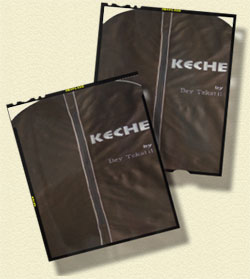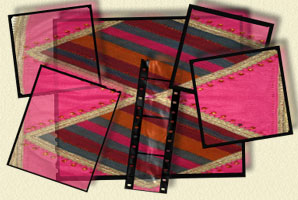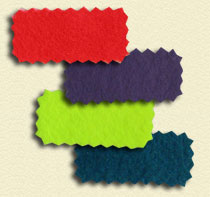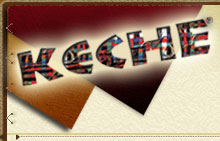 Our company, which adopted to principle of customer focus working since its foundation until today, is proud of offering the best quality of felt according to customer request in markets with 160 colour alternatives as unique in sector. Our company, which adopted to principle of customer focus working since its foundation until today, is proud of offering the best quality of felt according to customer request in markets with 160 colour alternatives as unique in sector.
As a specialist in using felt on embroidery and applique, our permanent aim is, keeping our existent quality line, providing our felt to take a part in world and being the best representative of our country in international area.
We, as Beytekstil, prepare our felt colour scala by following the fashion colours and evaluating our impression in national and international fairs and customer's requests. We combine our experience and quality with better care understanding and from day to day speed up our works to serve more alternative colour options and keep on our investments.
Until today, we prepared and served the wealthy felt colours
Our first scala is formed by 57 colour alternatives on 01.11.2003
Second scala is formed by 119 colour alternatives on 15.12.2004
Third scala is formed by 160 colour alternatives on 09.03.2006
In 2008, our aim is, being in the service of you, with our new scala, 300 colour alternatives.
|
Felt, or "keçe" is a fabric created primarily from sheep's wool. It may also be made from the fibers of hair of the camel, goat, horse, ox or any other animal. Unlike other fabrics, felt is not produced by the interleaving of welt and warp but by the interlocking and fusion of free woolen fibbers. Beacuse felt is basically wool, it has an important place among textiles. This is beause felt keeps out the cold, keeps one warm, and is waterproof. It is a particularly invariable part of normadic life. Felt was recognized by the Chinese as "a tribal or barbaric metarial" because in the old tribes of Central Asia, felt was used for every purpose, from making clothes to coverings. In fact, felt was actually known before cloth. Felt may be called the first textile. The first piece of felt was produced before 600 B.C.Spinning and weaving were later processes. The word " keçe" was used among the Turkmen living in Anatolia and in the western parts of.Central Asia.The word is also part of the language of other peoples who have produced and used felt. Names for felt have been created according to the region of production and in regard to size.
 |
|
 |
History of Felt
Many sources show that the use of felt goes back to before the Bronze Age. Written references trace the use of felt in China back to 2300 B.C. Archaeological findings in the Altai Mountains have revealed that the Turks of Central Asia used felt since very early times. The German couple Bidder, who have spent long years of research on this subject, point out that although felt was widely used by the Chinese, it was orginally a product of the nomads. Historians have determined that the Turks of Central Asia lived as nomadic tribes. As in other nomadic societies, the Turks adopted felt as an inescapable part of their daily life and used it in many forms. All Asian nomads produced felt, lived in felt houses, and wore clothes of felt. In the language of Eastern Turkistan the word "nomad" means "man of felt."
The felt pieces found in the Altai Mountains are varied. The digs have revealed floor and ceiling coverings as well as harnesses, belts, braids, cords and dresses of felt. Faruk Sümer relates what the islamic geographer Yakubi has written : " The Turks were masters in felt-making. All their clothing was of felt. We also know that the Huns wore clothing of felt and of leather." Thus it can be seen that the early Turks used felt in addition to leather and fur. There are records of the Seljuk Tuğrul Bey wearing boots of felt during a battle with the Ghaznavids.
The Turks used felt not only in their clothing but also in the domed one-room structures called "topakev"- "round house" or beg "yurt"-"home" that they these an to use in Central Asia. The tents were wrapped in felt; walls and material hung on the ground. In door and was laid on the totems were shamanistic rites the Central Asia affixed on felt. In "keçe" were the "topakev" and the another inseparable. As a very appropriate researcher says, "Felt is dry and cold winters of protection aganist the brought their tents Central Asia. The Turks Anatolia and continued ("topakev") with them to there. This sort of portable to live in them very convenient for such a house was nomadic people.
|

